2015届中考语法名师讲练【第1讲】名词
文档属性
| 名称 | 2015届中考语法名师讲练【第1讲】名词 | 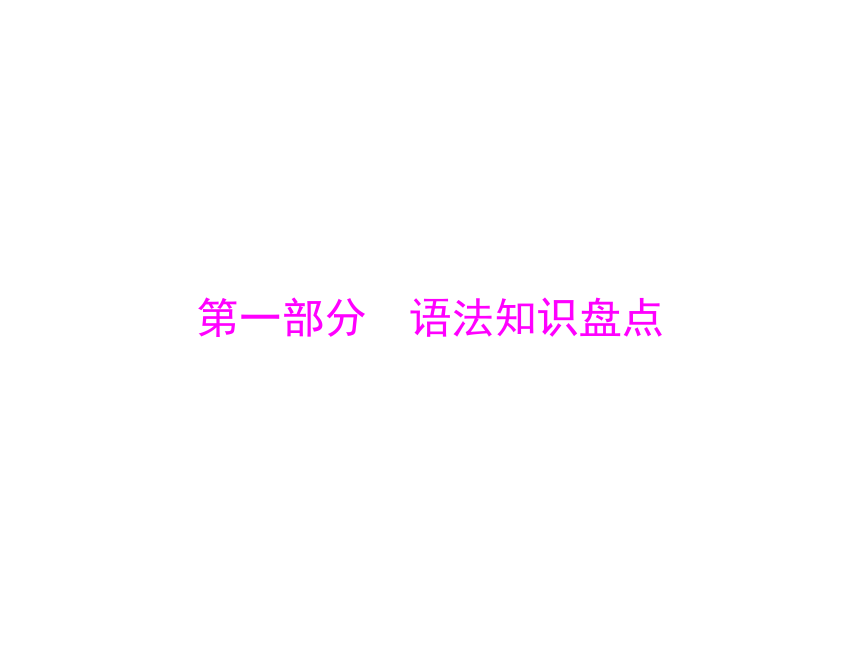 | |
| 格式 | zip | ||
| 文件大小 | 123.9KB | ||
| 资源类型 | 教案 | ||
| 版本资源 | 通用版 | ||
| 科目 | 英语 | ||
| 更新时间 | 2014-08-06 11:53:16 | ||
图片预览

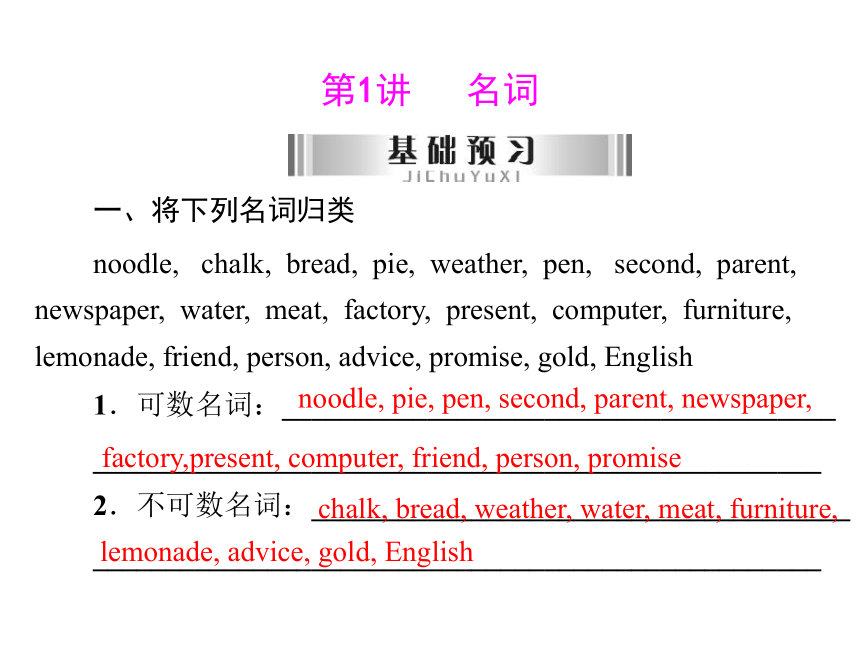
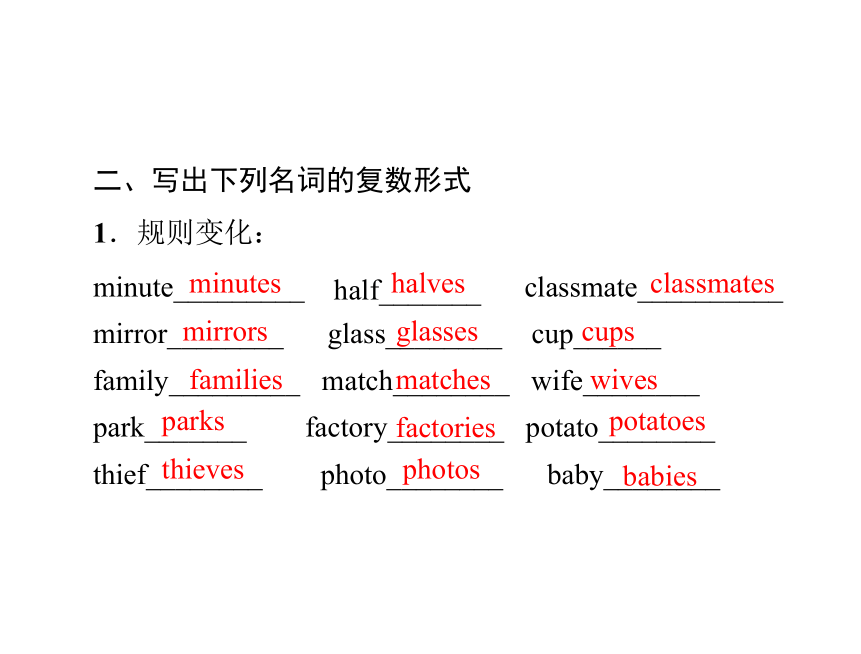
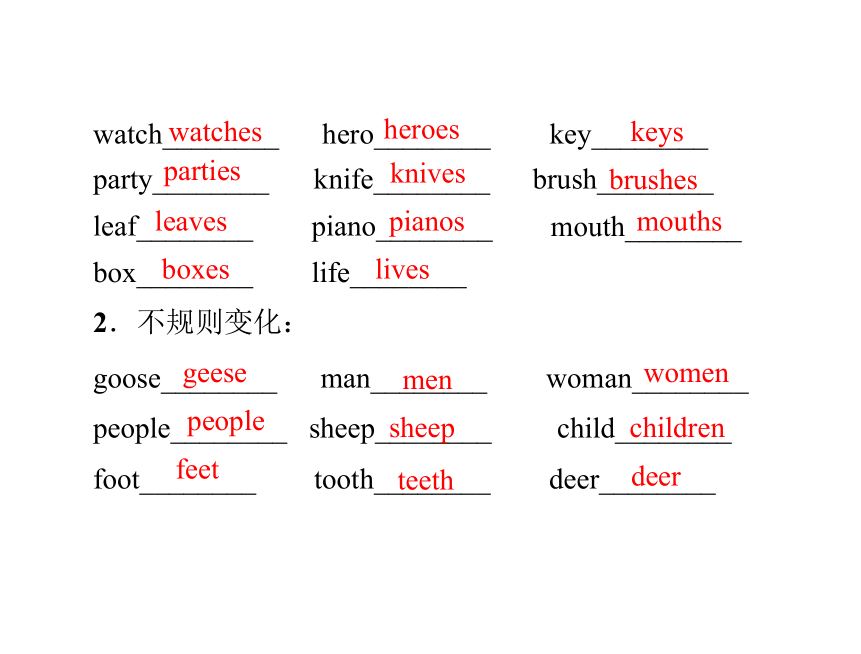
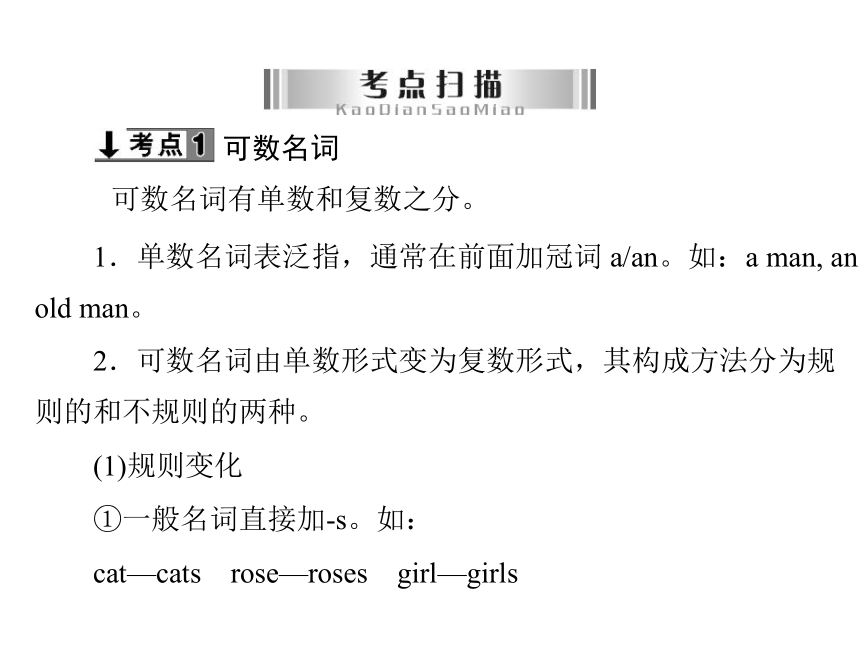
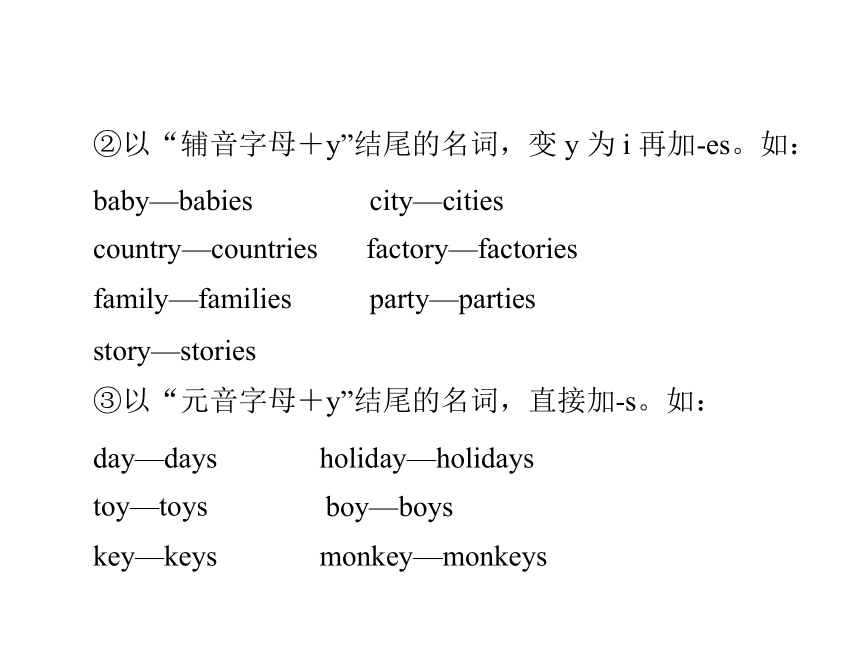
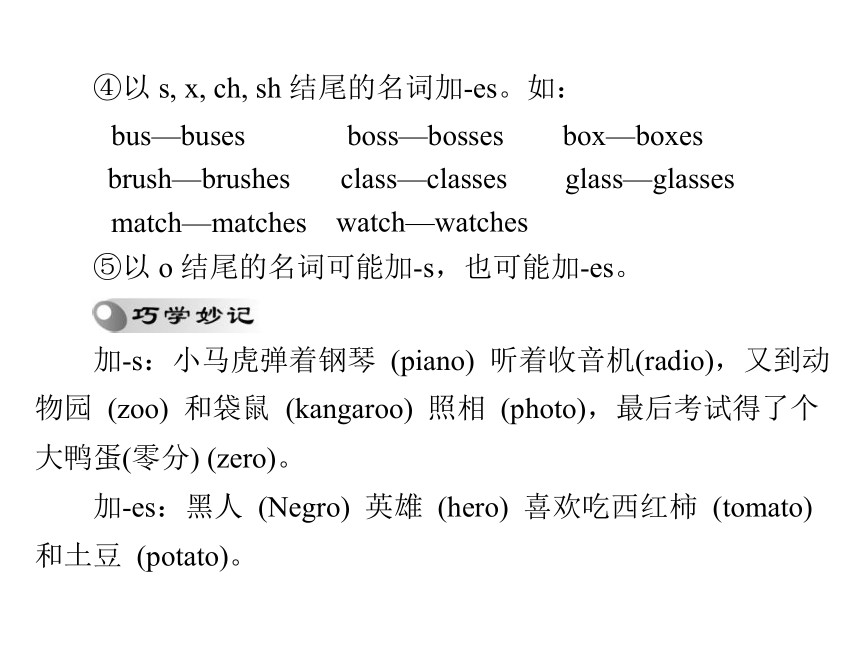
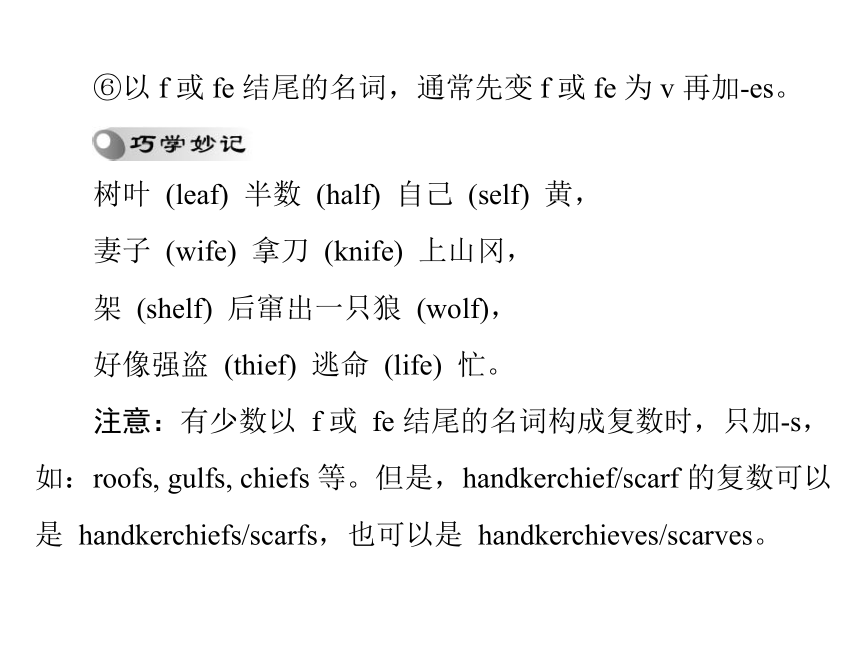
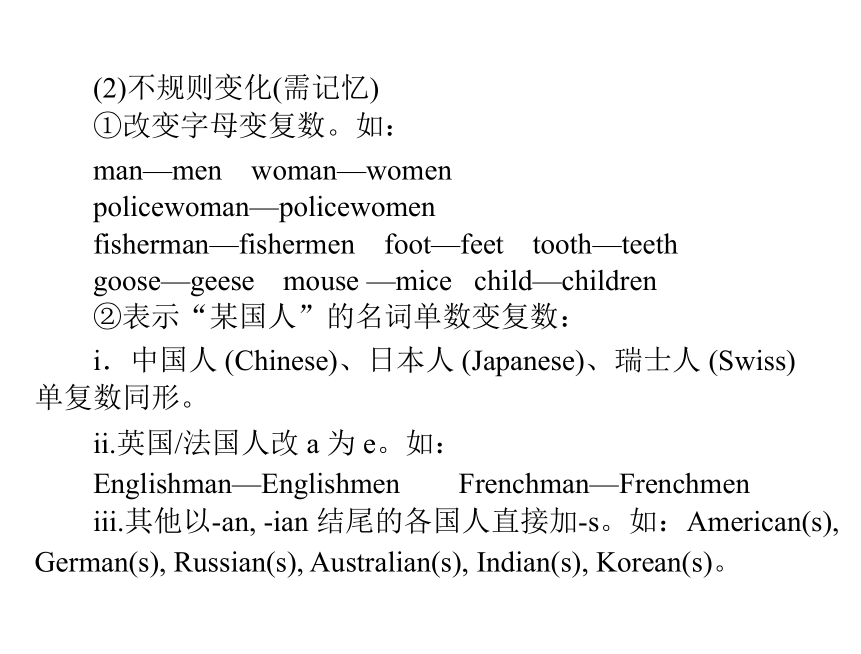
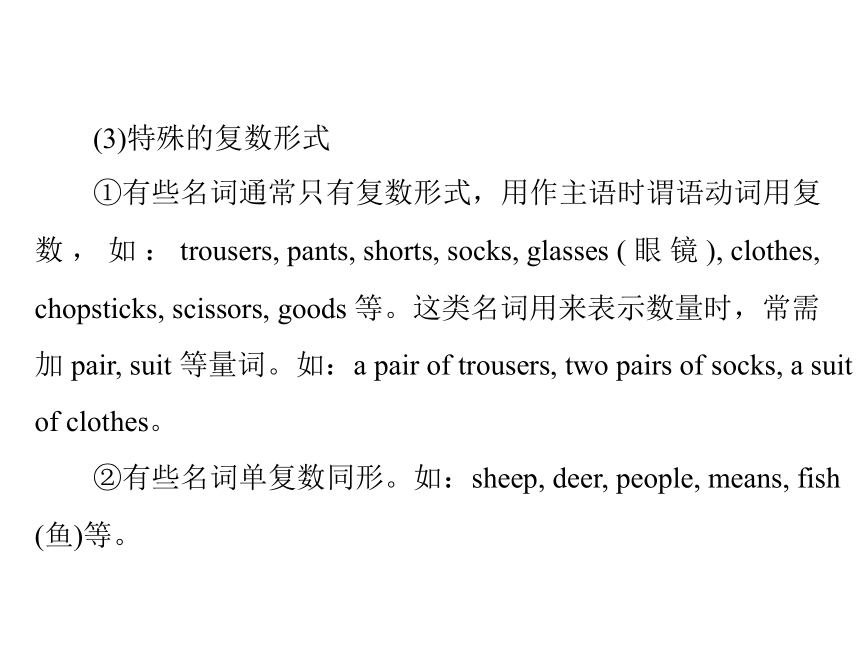
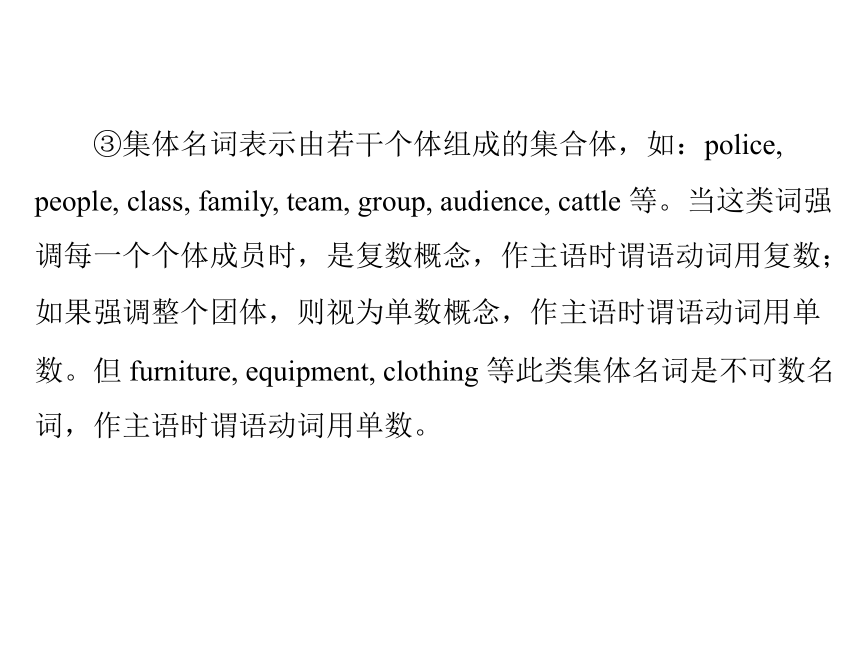
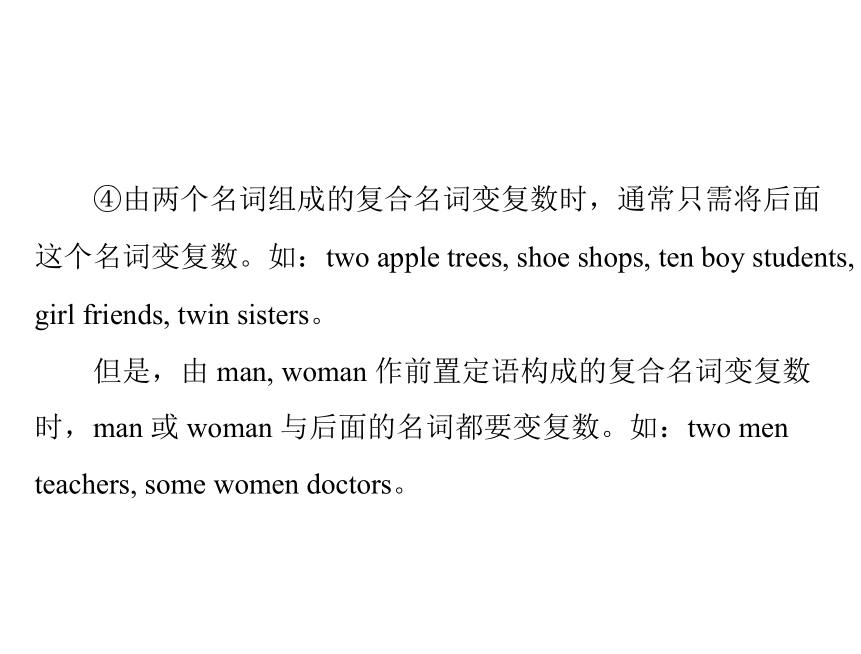
文档简介
课件39张PPT。第一部分 语法知识盘点第1讲名词 一、将下列名词归类
noodle, chalk, bread, pie, weather, pen, second, parent,
newspaper, water, meat, factory, present, computer, furniture,
lemonade, friend, person, advice, promise, gold, English
1.可数名词:______________________________________
__________________________________________________
2.不可数名词:_____________________________________
__________________________________________________ noodle, pie, pen, second, parent, newspaper,
factory,present, computer, friend, person, promise
chalk, bread, weather, water, meat, furniture,lemonade, advice, gold, Englishmirror________ glass________minuteshalvesclassmatesmirrorsglassescupsfamiliesmatcheswivesparksfactoriespotatoes二、写出下列名词的复数形式
1.规则变化:minute_________half_______classmate__________cup______family_________ match________ wife________park_______factory________ potato________thief________photo________baby________thievesphotosbabieswatches keys knivesbrushesleaves key________
brush________
mouth________watch________
party________
leaf________
box________ hero________
knife________
piano________
life________2.不规则变化:pianosmouthsboxeslivesgoose________man________woman________people________ sheep________child________foot________tooth________deer________geesemenwomenpeoplesheepchildrenfeet deerheroes partiesteeth 可数名词
可数名词有单数和复数之分。
1.单数名词表泛指,通常在前面加冠词 a/an。如:a man, an
old man。
2.可数名词由单数形式变为复数形式,其构成方法分为规
则的和不规则的两种。
(1)规则变化
①一般名词直接加-s。如:cat—catsrose—rosesgirl—girls②以“辅音字母+y”结尾的名词,变 y 为 i 再加-es。如:baby—babies
country—countries
family—families city—cities
factory—factories
party—partiesstory—stories
③以“元音字母+y”结尾的名词,直接加-s。如:day—days
toy—toys
key—keysholiday—holidays
boy—boys
monkey—monkeys④以 s, x, ch, sh 结尾的名词加-es。如:box—boxes
glass—glasses bus—buses
brush—brushes
match—matches boss—bosses
class—classes
watch—watches ⑤以 o 结尾的名词可能加-s,也可能加-es。
加-s:小马虎弹着钢琴 (piano) 听着收音机(radio),又到动
物园 (zoo) 和袋鼠 (kangaroo) 照相 (photo),最后考试得了个
大鸭蛋(零分) (zero)。
加-es:黑人 (Negro) 英雄 (hero) 喜欢吃西红柿 (tomato)
和土豆 (potato)。⑥以 f 或 fe 结尾的名词,通常先变 f 或 fe 为 v 再加-es。树叶 (leaf) 半数 (half) 自己 (self) 黄,
妻子 (wife) 拿刀 (knife) 上山冈,
架 (shelf) 后窜出一只狼 (wolf),
好像强盗 (thief) 逃命 (life) 忙。 注意:有少数以 f 或 fe 结尾的名词构成复数时,只加-s,
如:roofs, gulfs, chiefs 等。但是,handkerchief/scarf 的复数可以
是 handkerchiefs/scarfs,也可以是 handkerchieves/scarves。(2)不规则变化(需记忆)
①改变字母变复数。如:man—menwoman—womenpolicewoman—policewomenfisherman—fishermenfoot—feettooth—teethgoose—geesemouse —micechild—children ②表示“某国人”的名词单数变复数:
i.中国人 (Chinese)、日本人 (Japanese)、瑞士人 (Swiss)
单复数同形。
ii.英国/法国人改 a 为 e。如:Englishman—EnglishmenFrenchman—Frenchmen iii.其他以-an, -ian 结尾的各国人直接加-s。如:American(s),
German(s), Russian(s), Australian(s), Indian(s), Korean(s)。(3)特殊的复数形式 ①有些名词通常只有复数形式,用作主语时谓语动词用复
数 , 如 : trousers, pants, shorts, socks, glasses ( 眼 镜 ), clothes,
chopsticks, scissors, goods 等。这类名词用来表示数量时,常需
加 pair, suit 等量词。如:a pair of trousers, two pairs of socks, a suit
of clothes。②有些名词单复数同形。如:sheep, deer, people, means, fish(鱼)等。 ③集体名词表示由若干个体组成的集合体,如:police,
people, class, family, team, group, audience, cattle 等。当这类词强
调每一个个体成员时,是复数概念,作主语时谓语动词用复数;
如果强调整个团体,则视为单数概念,作主语时谓语动词用单
数。但 furniture, equipment, clothing 等此类集体名词是不可数名
词,作主语时谓语动词用单数。 ④由两个名词组成的复合名词变复数时,通常只需将后面
这个名词变复数。如:two apple trees, shoe shops, ten boy students,
girl friends, twin sisters。 但是,由 man, woman 作前置定语构成的复合名词变复数
时,man 或 woman 与后面的名词都要变复数。如:two men
teachers, some women doctors。注意:(1)有些名词的单复数形式的意义不同。如:
two fish 两条鱼two fishes 两种鱼类
some people 一些人some peoples 一些民族 (2)有些名词形式上是复数,但意义上是单数,一般看作单
数名词。如:news, mathematics/maths, physics, politics, the United
States, Niagara Falls 等。不可数名词1.不可数名词:一般指物质名词、抽象名词、专有名词等,没有复数形式,其前不用冠词 a/an 或数词。常见的不可数名词有:food, meat, fish, chicken, pork, beef,mutton, drink, orange, milk, tea, coke, water, rice, bread,
homework, news, paper, ice, rain, snow, wind, air, weather, work
等。分辨可数不可数的八句歌诀可数不可数好分辨,名词所示物分两半;
如每半不能叫原名,那该词可数最公平;
每半还能把原名叫,不可数名词就遇到;
有的名词是两面堵,意变不可数为可数。 注意:有些名词有两个或两个以上不同的意思,其中一个
意思表示不可数名词,另外一个表示可数名词。如:room 空间,余地,地方—a room 一间房间
paper 纸—a paper 一份试卷/一篇论文glass 玻璃—a glass 一个玻璃杯—glasses 眼镜
orange 橙子汁—an orange 一个橙子
chicken 鸡肉—a chicken 一只小鸡
drink 饮料—a drink 一份饮料
fish 鱼(肉)—fishes 鱼的种类
time 时间—times 时代,次数2.不可数名词量的表示(1)不能与 a/an 或数字直接连用,但特指某物时可与 the 连用。(2)前面可加“数词/冠词+量词(可数)+of”。如:a piece of paper/bread/news一张纸/一片面包/一则新闻two small bowls of rice 两小碗米饭 注意:
①加在不可数名词前的量词是可数的,所以当数词大于 1
时,量词要变为复数形式。如:two cups of tea/coffee
three glasses of water 两杯茶/咖啡
三杯水 four pieces of advice 四条建议
②可数名词有时也可以用“数词/ 冠词+量词( 可数) +
of”结构来表示数量。请区别:
two boxes of chalk 两盒粉笔
two boxes of pears 两箱梨 3 .不可数名词前可用 much, little, a little, a lot of/lots of,
some, any 等表示量。如:
some/much money 一些/很多钱
a lot of information 许多信息
名词所有格
名词所有格用来表示名词和名词之间的所属关系。
1.有生命的名词的所有格
(1)一般名词(不以-s 结尾)的所有格是在词尾加“'s ”。如:
Lily's father 莉莉的爸爸
mother's birthday 母亲的生日
Children's Day 儿童节men's clothes男式服装(2)以-s 或-es 结尾的名词,无论是单数还是复数,其所有格只需在后面加“'”。如:the doctors' office 医生办公室
the bus' door 公交车的门 (3)表示“两者(或以上)共同所有”时,只需在最后一个名
词后加“'s ”;若表示“两者(或以上)各自拥有”时,要在每一个
名词后都加“'s ”。如:Lucy and Lily's room 露西和莉莉的房间(共同所有,只有一个房间,room 用单数)Lucy's and Lily's rooms 露西的房间和莉莉的房间(各自拥有一个房间,room 用复数) (4)在表示“某人的家”、“某种从业者的工作地点(如店
铺、诊所、餐馆等)”的名词所有格后面,一般省掉它所修饰的
名词。如:at Mr.White's (house) 在怀特先生家
at the barber's (shop) 在理发店at the doctor's (office) 在医生的诊所 (5)双重所有格:在表示所属物的名词前有冠词、数词、
不 定 代词 或 指 示 代词 ( 如 a, two, some, a few, this, that, these,
those 等)时,用“of+名词所有格”或“of+名词性物主代词”
来表示所属关系。如:a photo of my father's我父亲的一张照片some inventions of Edison's
that novel of her brother's 爱迪生的一些发明
她兄弟的那本小说a friend of mine=one of my friends我的一位朋友some students of John's=some of John's students
约翰的一些学生2.无生命的名词的所有格(1)一些无生命的名词的所有格要用“of”来表示。如:
a map of China 一张中国地图
the foot of the hill 山脚the end of the term 学期末
the leaves of the tree 树叶the title of the text 课文的标题注意:如果名词后有一个较长的定语,尽管名词表示有生命的东西,也可用 of 表示所属关系。如:
the story of Dr.Smith 史密斯博士的故事the speech of President Obama 奥巴马总统的演讲(2)表示时间、距离、长度、重量、价格等名词的所有格要用“'s ”来表示。如:one hundred miles' journey 一百英里的旅程
a boat's length 一条船的长度
two pounds' weight 两磅的重量seven days' holiday=a seven-day holiday 七天的假期
six minutes' walk=a six-minute walk 步行六分钟的路程
ten dollars' worth 十美元的价值注意:一些名词表示所属关系时,通常并不使用所有格,而是借助于某些介词。如:
the key to the door 门的钥匙the way to the school 去学校的路the answer to the question 问题的答案 1.sound, voice, noise
(1)sound 指耳朵能听到的各种声音。
(2)voice 主要指人的嗓音和说话声音。
(3)noise 指噪音。即景活用voicenoisesound (1)Mary is a famous singer.She has a good ________.
(2)Don't make so much ________ in class.
(3)Can you hear the ________ of the water?2.work 与 job
(1)work 多指体力的或脑力的活动,为不可数名词。
(2)job 多指为换取报酬而进行的日常活动,为可数名词。即景活用jobwork He got a ________ by his hard________ at last.
3.problem 与 question
(1)problem 通常指客观上存在的等待解决的问题,尤其指
比较棘手的难题。
(2)question 通常指人主观上产生的疑问,以及用口头或书
面提出的问题。即景活用problemsquestions I have some ________ in learning English, so I should ask the
teacher a lot of ________ after class.
4.home, house, family
(1)home 指家,包括住处和家人。
(2)house 指房子、住宅。
(3)family 指家庭或家庭成员。即景活用housefamilyhome(1)We bought a new ________ near the river.
(2)All my ________ are watching the Spring Festival Gala.
(3)I miss my parents so much and I want to go ________.5.road, way, street (1)road 意为“公路,马路”,指两侧之间可供行人或车
辆通过的宽阔而又平坦的大道。“在马路上”一般用 on the
road。 (2)way 意为“路线;路途;方法”,指从一地到另一地
的路途或解决问题的办法。常用固定短语有:in this way (用这
种方式), on the way to (在去……的路上), get in the way of (挡道)
等。 (3)street 意为“街道”,主要指两侧有房屋的道路。“在街
上”一般用 in the street。即景活用waystreetroad (1)Excuse me, could you tell me the ________ to the post
office?
(2)When he went to work, he saw an old woman lying in the
________.
(3)The ________ in this village is wider than before.()1.(2014年广东)The students of Grade 7 visited Mike'sfarm and saw many ________there.A.bird
C.sheepB.duck
D.rabbit C many 修饰可数名词复数,bird, duck, rabbit 都是可数名
词,它们的复数都要加-s,故不能选。sheep 绵羊,它的单复数
同形,故选 C。()2.(2012 年广东茂名)________ school is quite near thebus station.
A.Ted and Tom's
B.Ted's and Tom's
C.Ted and Tom
A 由题中的 is 可知,这是 Ted 和 Tom 两人共同的学校,
故选 A。()3.(2014年广东深圳)—What are the ________ doingthere?
—They are busy ________ their science experiment.
A.boys students; to do
B.boy students; to do
C.boys students; doing
D.boy students; doing
D 两个名词构成复合名词,其复数形式常只将后一个名
词变为复数(man, woman 作定语除外);be busy doing sth.忙于做
某事。故选 D。()4.(2014 年广东)—I hear you run for half an hour everyday.
—Right, we have to.It is one of the ________ in our school. A.rules
C.hobbies B.plans
D.choices A 题意:“我听说你们每天都要跑步半小时。”“是的,
我们必须跑,这是我们学校的一条校规。”rules 规定;plans
计划;hobbies 爱好;choices 选择。故选 A。()5.(2012年广东深圳)—Could you please tell mesomething about the two ________?
—________.They are exchange students of No.1 Middle
School. A.Frenchmen; Yes, please
C.Germen; Not at allB.Frenchmans; Come on
D.Germans; All rightD第一空 two 的后面应该用名词复数,“法国人”和“德国人”的复数形式分别是 Frenchmen 和 Germans,故排除
B、C 项;第二空是回答上面的问句,结合后面句子可知应表示
“行,好的”的意思,故选 D。()6.(2014 年广东茂名)This is the first time in their________ to ski on the Apls.A. lifeB.lifesC.Lives C in one's life 在某人的生命里,而 their 后面应用名词复
数形式,life 的复数形式为 lives。故选 C。()7.(2011 年广东清远)I'm so hungry.Please give me________ to eat.
A.three bread
B.three pieces of bread
C.three pieces of breads
D.three piece of bread
B bread 为不可数名词,不能加-s 或直接与数词连用,排
除 A、C 项;因为是“三片面包”,故量词 piece 应用复数。选
B。()8.(2010 年广东)Look! The kites in the sky are indifferent ________.Some are big and some are small. A. size
C.colourB.sizes
D.colours B 题意:看,天上的风筝大小不一。有的大有的小。size
大小,尺寸;colour 颜色。由题意可排除 C、D 项,且题干中
风筝为复数,故选 B。()9.(2013 年广东深圳)—What ________ you usuallyhave for breakfast?
—________ and a cup of coffee.
A.do; Three bread
B.do; Three pieces of bread
C.are; Three breads
D.are; Three piece of bread
B 实义动词(have)的疑问句需要借助助动词 do,排除 C、
D 项;面包是不可数名词,表示“三片面包”要用 three pieces of
bread。故选 B。( )10.(2013 年广东湛江)—What's the date today?
—It's March 8th, ________ Day. A. Woman
C.Woman'sB.Women
D.Women's D 复数名词不是以-s 或-es 结尾时,其所有格仍要加's 。
Women's Day 妇女节。)11.(2010 年广东茂名)We can see two ________ in the (
picture.B.apples treesA.apple tree
C.apple treesCapple tree 为两个名词组成的复合名词,变为复数时只需将后面的名词变为复数,故选 C。
noodle, chalk, bread, pie, weather, pen, second, parent,
newspaper, water, meat, factory, present, computer, furniture,
lemonade, friend, person, advice, promise, gold, English
1.可数名词:______________________________________
__________________________________________________
2.不可数名词:_____________________________________
__________________________________________________ noodle, pie, pen, second, parent, newspaper,
factory,present, computer, friend, person, promise
chalk, bread, weather, water, meat, furniture,lemonade, advice, gold, Englishmirror________ glass________minuteshalvesclassmatesmirrorsglassescupsfamiliesmatcheswivesparksfactoriespotatoes二、写出下列名词的复数形式
1.规则变化:minute_________half_______classmate__________cup______family_________ match________ wife________park_______factory________ potato________thief________photo________baby________thievesphotosbabieswatches keys knivesbrushesleaves key________
brush________
mouth________watch________
party________
leaf________
box________ hero________
knife________
piano________
life________2.不规则变化:pianosmouthsboxeslivesgoose________man________woman________people________ sheep________child________foot________tooth________deer________geesemenwomenpeoplesheepchildrenfeet deerheroes partiesteeth 可数名词
可数名词有单数和复数之分。
1.单数名词表泛指,通常在前面加冠词 a/an。如:a man, an
old man。
2.可数名词由单数形式变为复数形式,其构成方法分为规
则的和不规则的两种。
(1)规则变化
①一般名词直接加-s。如:cat—catsrose—rosesgirl—girls②以“辅音字母+y”结尾的名词,变 y 为 i 再加-es。如:baby—babies
country—countries
family—families city—cities
factory—factories
party—partiesstory—stories
③以“元音字母+y”结尾的名词,直接加-s。如:day—days
toy—toys
key—keysholiday—holidays
boy—boys
monkey—monkeys④以 s, x, ch, sh 结尾的名词加-es。如:box—boxes
glass—glasses bus—buses
brush—brushes
match—matches boss—bosses
class—classes
watch—watches ⑤以 o 结尾的名词可能加-s,也可能加-es。
加-s:小马虎弹着钢琴 (piano) 听着收音机(radio),又到动
物园 (zoo) 和袋鼠 (kangaroo) 照相 (photo),最后考试得了个
大鸭蛋(零分) (zero)。
加-es:黑人 (Negro) 英雄 (hero) 喜欢吃西红柿 (tomato)
和土豆 (potato)。⑥以 f 或 fe 结尾的名词,通常先变 f 或 fe 为 v 再加-es。树叶 (leaf) 半数 (half) 自己 (self) 黄,
妻子 (wife) 拿刀 (knife) 上山冈,
架 (shelf) 后窜出一只狼 (wolf),
好像强盗 (thief) 逃命 (life) 忙。 注意:有少数以 f 或 fe 结尾的名词构成复数时,只加-s,
如:roofs, gulfs, chiefs 等。但是,handkerchief/scarf 的复数可以
是 handkerchiefs/scarfs,也可以是 handkerchieves/scarves。(2)不规则变化(需记忆)
①改变字母变复数。如:man—menwoman—womenpolicewoman—policewomenfisherman—fishermenfoot—feettooth—teethgoose—geesemouse —micechild—children ②表示“某国人”的名词单数变复数:
i.中国人 (Chinese)、日本人 (Japanese)、瑞士人 (Swiss)
单复数同形。
ii.英国/法国人改 a 为 e。如:Englishman—EnglishmenFrenchman—Frenchmen iii.其他以-an, -ian 结尾的各国人直接加-s。如:American(s),
German(s), Russian(s), Australian(s), Indian(s), Korean(s)。(3)特殊的复数形式 ①有些名词通常只有复数形式,用作主语时谓语动词用复
数 , 如 : trousers, pants, shorts, socks, glasses ( 眼 镜 ), clothes,
chopsticks, scissors, goods 等。这类名词用来表示数量时,常需
加 pair, suit 等量词。如:a pair of trousers, two pairs of socks, a suit
of clothes。②有些名词单复数同形。如:sheep, deer, people, means, fish(鱼)等。 ③集体名词表示由若干个体组成的集合体,如:police,
people, class, family, team, group, audience, cattle 等。当这类词强
调每一个个体成员时,是复数概念,作主语时谓语动词用复数;
如果强调整个团体,则视为单数概念,作主语时谓语动词用单
数。但 furniture, equipment, clothing 等此类集体名词是不可数名
词,作主语时谓语动词用单数。 ④由两个名词组成的复合名词变复数时,通常只需将后面
这个名词变复数。如:two apple trees, shoe shops, ten boy students,
girl friends, twin sisters。 但是,由 man, woman 作前置定语构成的复合名词变复数
时,man 或 woman 与后面的名词都要变复数。如:two men
teachers, some women doctors。注意:(1)有些名词的单复数形式的意义不同。如:
two fish 两条鱼two fishes 两种鱼类
some people 一些人some peoples 一些民族 (2)有些名词形式上是复数,但意义上是单数,一般看作单
数名词。如:news, mathematics/maths, physics, politics, the United
States, Niagara Falls 等。不可数名词1.不可数名词:一般指物质名词、抽象名词、专有名词等,没有复数形式,其前不用冠词 a/an 或数词。常见的不可数名词有:food, meat, fish, chicken, pork, beef,mutton, drink, orange, milk, tea, coke, water, rice, bread,
homework, news, paper, ice, rain, snow, wind, air, weather, work
等。分辨可数不可数的八句歌诀可数不可数好分辨,名词所示物分两半;
如每半不能叫原名,那该词可数最公平;
每半还能把原名叫,不可数名词就遇到;
有的名词是两面堵,意变不可数为可数。 注意:有些名词有两个或两个以上不同的意思,其中一个
意思表示不可数名词,另外一个表示可数名词。如:room 空间,余地,地方—a room 一间房间
paper 纸—a paper 一份试卷/一篇论文glass 玻璃—a glass 一个玻璃杯—glasses 眼镜
orange 橙子汁—an orange 一个橙子
chicken 鸡肉—a chicken 一只小鸡
drink 饮料—a drink 一份饮料
fish 鱼(肉)—fishes 鱼的种类
time 时间—times 时代,次数2.不可数名词量的表示(1)不能与 a/an 或数字直接连用,但特指某物时可与 the 连用。(2)前面可加“数词/冠词+量词(可数)+of”。如:a piece of paper/bread/news一张纸/一片面包/一则新闻two small bowls of rice 两小碗米饭 注意:
①加在不可数名词前的量词是可数的,所以当数词大于 1
时,量词要变为复数形式。如:two cups of tea/coffee
three glasses of water 两杯茶/咖啡
三杯水 four pieces of advice 四条建议
②可数名词有时也可以用“数词/ 冠词+量词( 可数) +
of”结构来表示数量。请区别:
two boxes of chalk 两盒粉笔
two boxes of pears 两箱梨 3 .不可数名词前可用 much, little, a little, a lot of/lots of,
some, any 等表示量。如:
some/much money 一些/很多钱
a lot of information 许多信息
名词所有格
名词所有格用来表示名词和名词之间的所属关系。
1.有生命的名词的所有格
(1)一般名词(不以-s 结尾)的所有格是在词尾加“'s ”。如:
Lily's father 莉莉的爸爸
mother's birthday 母亲的生日
Children's Day 儿童节men's clothes男式服装(2)以-s 或-es 结尾的名词,无论是单数还是复数,其所有格只需在后面加“'”。如:the doctors' office 医生办公室
the bus' door 公交车的门 (3)表示“两者(或以上)共同所有”时,只需在最后一个名
词后加“'s ”;若表示“两者(或以上)各自拥有”时,要在每一个
名词后都加“'s ”。如:Lucy and Lily's room 露西和莉莉的房间(共同所有,只有一个房间,room 用单数)Lucy's and Lily's rooms 露西的房间和莉莉的房间(各自拥有一个房间,room 用复数) (4)在表示“某人的家”、“某种从业者的工作地点(如店
铺、诊所、餐馆等)”的名词所有格后面,一般省掉它所修饰的
名词。如:at Mr.White's (house) 在怀特先生家
at the barber's (shop) 在理发店at the doctor's (office) 在医生的诊所 (5)双重所有格:在表示所属物的名词前有冠词、数词、
不 定 代词 或 指 示 代词 ( 如 a, two, some, a few, this, that, these,
those 等)时,用“of+名词所有格”或“of+名词性物主代词”
来表示所属关系。如:a photo of my father's我父亲的一张照片some inventions of Edison's
that novel of her brother's 爱迪生的一些发明
她兄弟的那本小说a friend of mine=one of my friends我的一位朋友some students of John's=some of John's students
约翰的一些学生2.无生命的名词的所有格(1)一些无生命的名词的所有格要用“of”来表示。如:
a map of China 一张中国地图
the foot of the hill 山脚the end of the term 学期末
the leaves of the tree 树叶the title of the text 课文的标题注意:如果名词后有一个较长的定语,尽管名词表示有生命的东西,也可用 of 表示所属关系。如:
the story of Dr.Smith 史密斯博士的故事the speech of President Obama 奥巴马总统的演讲(2)表示时间、距离、长度、重量、价格等名词的所有格要用“'s ”来表示。如:one hundred miles' journey 一百英里的旅程
a boat's length 一条船的长度
two pounds' weight 两磅的重量seven days' holiday=a seven-day holiday 七天的假期
six minutes' walk=a six-minute walk 步行六分钟的路程
ten dollars' worth 十美元的价值注意:一些名词表示所属关系时,通常并不使用所有格,而是借助于某些介词。如:
the key to the door 门的钥匙the way to the school 去学校的路the answer to the question 问题的答案 1.sound, voice, noise
(1)sound 指耳朵能听到的各种声音。
(2)voice 主要指人的嗓音和说话声音。
(3)noise 指噪音。即景活用voicenoisesound (1)Mary is a famous singer.She has a good ________.
(2)Don't make so much ________ in class.
(3)Can you hear the ________ of the water?2.work 与 job
(1)work 多指体力的或脑力的活动,为不可数名词。
(2)job 多指为换取报酬而进行的日常活动,为可数名词。即景活用jobwork He got a ________ by his hard________ at last.
3.problem 与 question
(1)problem 通常指客观上存在的等待解决的问题,尤其指
比较棘手的难题。
(2)question 通常指人主观上产生的疑问,以及用口头或书
面提出的问题。即景活用problemsquestions I have some ________ in learning English, so I should ask the
teacher a lot of ________ after class.
4.home, house, family
(1)home 指家,包括住处和家人。
(2)house 指房子、住宅。
(3)family 指家庭或家庭成员。即景活用housefamilyhome(1)We bought a new ________ near the river.
(2)All my ________ are watching the Spring Festival Gala.
(3)I miss my parents so much and I want to go ________.5.road, way, street (1)road 意为“公路,马路”,指两侧之间可供行人或车
辆通过的宽阔而又平坦的大道。“在马路上”一般用 on the
road。 (2)way 意为“路线;路途;方法”,指从一地到另一地
的路途或解决问题的办法。常用固定短语有:in this way (用这
种方式), on the way to (在去……的路上), get in the way of (挡道)
等。 (3)street 意为“街道”,主要指两侧有房屋的道路。“在街
上”一般用 in the street。即景活用waystreetroad (1)Excuse me, could you tell me the ________ to the post
office?
(2)When he went to work, he saw an old woman lying in the
________.
(3)The ________ in this village is wider than before.()1.(2014年广东)The students of Grade 7 visited Mike'sfarm and saw many ________there.A.bird
C.sheepB.duck
D.rabbit C many 修饰可数名词复数,bird, duck, rabbit 都是可数名
词,它们的复数都要加-s,故不能选。sheep 绵羊,它的单复数
同形,故选 C。()2.(2012 年广东茂名)________ school is quite near thebus station.
A.Ted and Tom's
B.Ted's and Tom's
C.Ted and Tom
A 由题中的 is 可知,这是 Ted 和 Tom 两人共同的学校,
故选 A。()3.(2014年广东深圳)—What are the ________ doingthere?
—They are busy ________ their science experiment.
A.boys students; to do
B.boy students; to do
C.boys students; doing
D.boy students; doing
D 两个名词构成复合名词,其复数形式常只将后一个名
词变为复数(man, woman 作定语除外);be busy doing sth.忙于做
某事。故选 D。()4.(2014 年广东)—I hear you run for half an hour everyday.
—Right, we have to.It is one of the ________ in our school. A.rules
C.hobbies B.plans
D.choices A 题意:“我听说你们每天都要跑步半小时。”“是的,
我们必须跑,这是我们学校的一条校规。”rules 规定;plans
计划;hobbies 爱好;choices 选择。故选 A。()5.(2012年广东深圳)—Could you please tell mesomething about the two ________?
—________.They are exchange students of No.1 Middle
School. A.Frenchmen; Yes, please
C.Germen; Not at allB.Frenchmans; Come on
D.Germans; All rightD第一空 two 的后面应该用名词复数,“法国人”和“德国人”的复数形式分别是 Frenchmen 和 Germans,故排除
B、C 项;第二空是回答上面的问句,结合后面句子可知应表示
“行,好的”的意思,故选 D。()6.(2014 年广东茂名)This is the first time in their________ to ski on the Apls.A. lifeB.lifesC.Lives C in one's life 在某人的生命里,而 their 后面应用名词复
数形式,life 的复数形式为 lives。故选 C。()7.(2011 年广东清远)I'm so hungry.Please give me________ to eat.
A.three bread
B.three pieces of bread
C.three pieces of breads
D.three piece of bread
B bread 为不可数名词,不能加-s 或直接与数词连用,排
除 A、C 项;因为是“三片面包”,故量词 piece 应用复数。选
B。()8.(2010 年广东)Look! The kites in the sky are indifferent ________.Some are big and some are small. A. size
C.colourB.sizes
D.colours B 题意:看,天上的风筝大小不一。有的大有的小。size
大小,尺寸;colour 颜色。由题意可排除 C、D 项,且题干中
风筝为复数,故选 B。()9.(2013 年广东深圳)—What ________ you usuallyhave for breakfast?
—________ and a cup of coffee.
A.do; Three bread
B.do; Three pieces of bread
C.are; Three breads
D.are; Three piece of bread
B 实义动词(have)的疑问句需要借助助动词 do,排除 C、
D 项;面包是不可数名词,表示“三片面包”要用 three pieces of
bread。故选 B。( )10.(2013 年广东湛江)—What's the date today?
—It's March 8th, ________ Day. A. Woman
C.Woman'sB.Women
D.Women's D 复数名词不是以-s 或-es 结尾时,其所有格仍要加's 。
Women's Day 妇女节。)11.(2010 年广东茂名)We can see two ________ in the (
picture.B.apples treesA.apple tree
C.apple treesCapple tree 为两个名词组成的复合名词,变为复数时只需将后面的名词变为复数,故选 C。
同课章节目录
- 词法
- 名词
- 动词和动词短语
- 动词语态
- 动词时态
- 助动词和情态动词
- 非谓语动词
- 冠词
- 代词
- 数词和量词
- 形容词副词及其比较等级
- 介词和介词短语
- 连词和感叹词
- 构词法
- 相似、相近词比较
- 句法
- 陈述句
- 一般疑问句和否定疑问句
- 特殊疑问句及选择疑问句
- 反意疑问句
- 存在句(There be句型)
- 宾语从句
- 定语从句
- 状语从句
- 主谓一致问题
- 简单句
- 并列句
- 复合句
- 主谓一致
- 主、表语从句
- 名词性从句
- 直接引语和间接引语
- 虚拟语气
- 感叹句
- 强调句
- 倒装句
- 祈使句
- 句子的成分
- 句子的分类
- 题型专区
- 单项选择部分
- 易错题
- 完形填空
- 阅读理解
- 词汇练习
- 听说训练
- 句型转换
- 补全对话
- 短文改错
- 翻译
- 书面表达
- 任务型阅读
- 语法填空
- 其他资料
